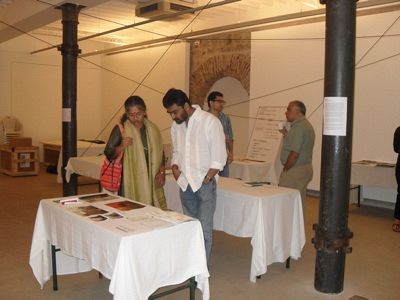Roughly thirty years ago, in the late sixties and early seventies, a revolution in painting occurred. A number of artists in Europe and the United States developed new ways of painting that disregarded any traditional notion of what constitutes a work of art. Robert Ryman, Niele Toroni, John McCracken and Daniel Buren, among others, reduced their practice to the “basics,” variously eliminating brush stroke, color, and canvas. The exhibition Painting Zero Degree maps some of the radical pictorial practices these artists proposed and, at the height of a recurrence of painting, introduces a rereading of their strategies by an eclectic international group of young artists who, like their predecessors, work in untraditional media that now also include industrial materials, furniture, clothing, and video. New works will be created specifically for the exhibition by five of the fourteen artists, including John McCracken.
Developed in close collaboration with the curatorial staff at each institution, Painting Zero Degree is installed differently at each venue, with many of the pieces tailored by each institution to its own exhibition spaces. This element of transformation directly addresses the interests of many museums and artists and the specific conditions of a traveling exhibition. Inspired by French philosopher Roland Barthes’ book Writing Degree Zero, the exhibition identifies pictorial practices that fit neither the concept of an “autonomous,” truly abstract painting nor that of the ready-made, an object transposed from a specific context. The works assembled here alternatively approach one or the other position, marking an ambiguous and complex place between specific context and the conditions established by the Modernist tradition of abstract painting.
The introductory section of the exhibition is comprised of older as well as recent works by Buren, Toroni, Ryman and McCracken. Buren’s radical proposition of breaking the traditional relationship between pictorial practice and canvas in order to extend that practice to the environment is still vital and rich. His decision not to abandon the specificity of the medium – paint – but rather to question its relation with the institutional context – a museum or gallery space – has proved to have wide ranging implications still not fully explored. To this exhibition, he contributes one of his rare floor pieces that will turn the gallery floor into one of his trademark striped environments. Toroni’s approach may be considered the perfect counterpart to Buren. Toroni broke both the relation between the pictorial gesture and the canvas and isolated the brush stroke as the minimum component of painting or wallpaper – as in this show. Ryman developed a parallel methodology by focusing exclusively on the qualities of brush stroke and the support, seemingly eliminating color and composition. Four of his paintings, two from his personal collection, are included in the exhibition. On the West Coast, John McCracken isolated color and form, producing a series of pieces where the practice of painting borders on design without ever being absorbed into its utilitarianism. He created three new pieces for Painting Zero Degree.
Leaning closely on these four historical figures, Painting Zero Degree moves into a strictly contemporary domain and introduces works by ten younger artists: Fabio Kacero (Argentina, b. 1961), Clay Ketter (USA/Sweden, b. 1961), Peter Kogler (Austria, b. 1958), Felipe Mujica (Chile, b. 1974), Gladys Nistor (Argentina/France, b. 1960), Karin Sander (Germany, b. 1958), Adrian Schiess (Switzerland, b. 1959), Pablo Siquier (Argentina, b. 1961), Sophie Smallhorn (Great Britain, b. 1971), and Rudolf Stingel (Italy/Switzerland, b. 1956).
Kacero’s abstract pictorial signs are mounted on inflated canvases that resemble pillows. Ketter’s artifacts evoke unfinished kitchen furniture and play with the idea of painting being reduced to its minimum and almost transformed into an element of daily life. Both Stingel’s color field carpets and Kogler’s wallpaper are tailored to the specific architecture at each venue. Mujica designs flexible structures that act like three-dimensional game boards and can be entered by the gallery visitor. Nistor applies to the wall pieces of felt contact paper whose stark black outlines recall architectural features such as windows. Schiess’ digitally composed video “paintings” are large-scale projections whose colors mutate ever so slightly over the course of an hour. Siquier reduces painting to compositional problems by elimination color and isolating an array of digitally designed black lines on a white canvas. Sander contributes one small white monochrome work with one red brush stroke, to be mounted on a wall by itself. Smallhorn translates illusionistic painterly space into three-dimensional objects void of any apparent content.
Accompanying this exhibition is the catalogue Painting Zero Degree, edited by Carlos Basualdo and published by Independent Curators International (ICI). Please visit our shop for more information.







